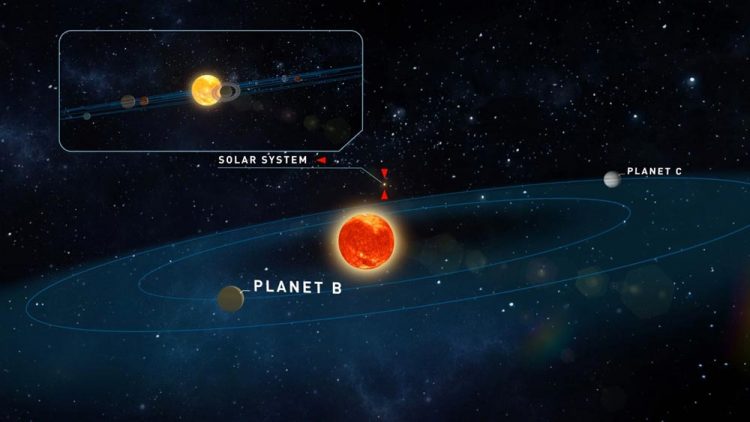View of the Earth in front of the Sun

Teegarden’s Star and its two planets, our Solar System in the background Photo: University of Göttingen, Institute for Astrophysics
Their data clearly show the existence of two planets. “The two planets resemble the inner planets of our solar system,” explains lead author Mathias Zechmeister of the Institute for Astrophysics at the University of Göttingen.
“They are only slightly heavier than Earth and are located in the so-called habitable zone, where water can be present in liquid form.”
The astronomers suspect that the two planets could be part of a larger system. “Many stars are apparently surrounded by systems with several planets,” explains co-author Professor Stefan Dreizler of the University of Göttingen.
Teegarden's star is the smallest star where researchers have so far been able to measure the weight of a planet directly. “This is a great success for the Carmenes project, which was specifically designed to search for planets around the lightest stars,” says Professor Ansgar Reiners of the University of Göttingen, one of the scientific directors of the project.
Although planetary systems around similar stars are known, they have always been detected using the “transit method” – the planets have to pass visibly in front of the star and darken it for a moment, which only happens in a very small fraction of all planetary systems.
Such transits have not yet been found for the new planets. But the system is located at a special place in the sky: from Teegarden's star you can see the planets of the solar system passing in front of the Sun.
“An inhabitant of the new planets would therefore have the opportunity to view the Earth using the transit method,” says Reiners. The new planets are the tenth and eleventh discovered by the team.
Carmenes is carried out by the universities of Göttingen, Hamburg, Heidelberg, and Madrid, the Max-Planck-Institut für Astronomie Heidelberg, Institutes Consejo Superior de Investigaciones Científicas in Barcelona, Granada, and Madrid, Thüringer Landessternwarte, Instituto de Astrofísica de Canarias, and Calar-Alto Observatory. Further information can be found at https://carmenes.caha.es.
University of Göttingen
Institute for Astrophysics:
Dr Mathias Zechmeister
Tel: +49 (0)551 39-9988
Email: zechmeister@astro.physik.uni-goettingen.de
Internet: http://www.astro.physik.uni-goettingen.de/~zechmeister/
Professor Ansgar Reiners
Tel: +49 (0)551 39-13825
Email: ansgar.reiners@phys.uni-goettingen.de
Internet: http://www.uni-goettingen.de/de/homepage/574854.html
Professor Stefan Dreizler
Tel: +49 (0)551 39-5041
Email: dreizler@astro.physik.uni-goettingen.de
Internet: http://www.uni-goettingen.de/de/216891.html
Mathias Zechmeister et al. The CARMENES search for exoplanets around M dwarfs – Two temperate Earth-mass planet candidates around Teegarden’s Star. Astronomy & Astrophysics 2019. DOI: http://10.1051/0004-6361/201935460
Media Contact
All latest news from the category: Physics and Astronomy
This area deals with the fundamental laws and building blocks of nature and how they interact, the properties and the behavior of matter, and research into space and time and their structures.
innovations-report provides in-depth reports and articles on subjects such as astrophysics, laser technologies, nuclear, quantum, particle and solid-state physics, nanotechnologies, planetary research and findings (Mars, Venus) and developments related to the Hubble Telescope.
Newest articles

First-of-its-kind study uses remote sensing to monitor plastic debris in rivers and lakes
Remote sensing creates a cost-effective solution to monitoring plastic pollution. A first-of-its-kind study from researchers at the University of Minnesota Twin Cities shows how remote sensing can help monitor and…

Laser-based artificial neuron mimics nerve cell functions at lightning speed
With a processing speed a billion times faster than nature, chip-based laser neuron could help advance AI tasks such as pattern recognition and sequence prediction. Researchers have developed a laser-based…

Optimising the processing of plastic waste
Just one look in the yellow bin reveals a colourful jumble of different types of plastic. However, the purer and more uniform plastic waste is, the easier it is to…


